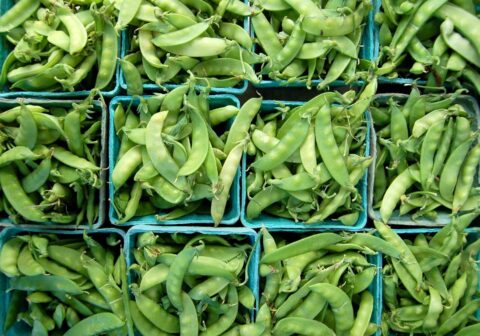Perspective
Can Men Help the Climate by Eating Less Meat?
Climate•5 min read
Perspective
Feeding the rapidly growing human population, expected to exceed 10 billion people by 2050, hinges on the ability of individual farmers to adopt more sustainable plant-based foods.

Perspective • Climate • Food

Words by Nicholas Carter
 This story is a part of Covering Climate Now’s week of coverage focused on Climate Solutions, to mark the 50th anniversary of Earth Day. Covering Climate Now is a global journalism collaboration committed to strengthening coverage of the climate story.
This story is a part of Covering Climate Now’s week of coverage focused on Climate Solutions, to mark the 50th anniversary of Earth Day. Covering Climate Now is a global journalism collaboration committed to strengthening coverage of the climate story.Our planet has boundaries for which it can withstand various environmental stresses. In 2009, the concept of “planetary boundaries” was coined by scientist Johan Rockström, who observed that climate change is only one of nine interrelated planetary limits required to maintain a safe operating space for humanity. Widespread among almost all of these boundaries is the impact of the agriculture industry, specifically animal agriculture, on the planet. Animal agriculture is the number one stressor in many of these categories, including land change use, biodiversity loss, freshwater use, and the disruption of nitrogen and phosphorus cycles due to chemical fertilizers.
While fossil fuels are a major source of greenhouse gas (GHG) emissions, new research using a full life-cycle analysis suggests that livestock systems are responsible for at least 37 percent of GHG emissions—and are almost always underestimated by intergovernmental organizations and research scientists alike. This is not intended to minimize the impact of other high-emitting sectors, as addressing planetary boundaries and climate change requires efforts in any and all significant areas. However, as shown here, agriculture can both reduce GHG emissions and sequester current emissions already in the atmosphere, highlighting the importance of agriculture’s emerging role in environmental protection strategies.
Is an agriculture system dominated by farmed animals the solution? Absolutely not. Farming animals is both land- and resource-intensive. To provide just 18 percent of the global food system’s calories (or 37 percent of protein), livestock farming occupies 83 percent of all agricultural land. For every 100 calories of grain fed to farmed animals, humans receive only:
🥛 40 calories of milk, or
🥚 22 calories of eggs, or
🐔 12 calories of chicken, or
🐖 10 calories of pork, or
🐄 3 calories of beef.
Animal agriculture is an unsustainable and inefficient way to feed the world. Now, the solution is clear. We need an agricultural system primarily, or entirely, focused on farming plants.
According to a report from the Humane Party, plant-based farming has the capacity to grow 512 percent more food by weight than the entire animal agriculture industry on just 69 percent of the land that animal-based agriculture uses. Economically, plant-based agriculture makes an average of $1.44 more per $100 sold than animal-based agriculture. New data shows the plant-based retail food business has now reached $5 billion as of 2019, up 29 percent over the past two years.
In 2019, a Harvard study revealed the massive amount of land used for animal feed crops in the United Kingdom. Even if only 1 percent of the UK’s animal feed cropland could be switched to feed humans directly, the converted land would show a substantial increase—up to 5028 percent—in the domestic food supply. This is due to the inefficiencies and poor conversion rates of feeding farmed animals.
But aren’t farmed animals good for the land, and isn’t their waste a natural form of fertilizer?
This is a myth perpetuated over and over again, unfortunately. Among many issues with agriculture is the overproduction and overuse of livestock manure. Every year, 1.37 billion tons of solid animal waste is produced in the U.S. That’s 130 times more solid waste than the amount produced by humans. Farmed animals produce about 116,000 pounds of excrement every second in the U.S. alone. Globally, they produce enough waste per year to cover every square foot of San Francisco, New York City, Tokyo, Paris, New Delhi, Berlin, Hong Kong, London, Rio de Janeiro, Delaware, Bali, Costa Rica, and Denmark—combined.
Because farmed animals produce so much waste, not all of it can be used as fertilizer. The excess manure sits, sometimes permanently, in lagoons around the country. But more often than not, persistent leaks in the lagoons cause manure runoff from factory farms to contaminate nearby rivers, lakes, oceans, and groundwater. In 2018, from Hurricane Florence, at least 110 lagoons released pig waste into North Carolina’s waterways. Overall, the EPA found that groundwater sources in one-third of U.S. states are contaminated with animal waste.
It’s no wonder that animal agriculture is the leading cause of ocean dead zones and water pollution.
Livestock manure is often misunderstood as a perfect organic fertilizer that is easily absorbed by the soil. However, far more is produced than could ever be redistributed effectively as fertilizer. In storage, the manure becomes a toxic cesspool of nitrous oxide, methane, CO2, ammonia, and hydrogen sulfide. As shown below in the graphic comparing the mass of animals in 10,000 BCE to 2015, animal waste from livestock production is driving the global ecosystem out of balance.
Is using synthetic fertilizers superior to using livestock waste? No, they both have issues. Synthetic fertilizers rely on fossil fuels to be produced and can lead to significant nitrogen leaching into waterways. Luckily, there are ways to farm plants in regenerative manners that have a multitude of benefits.
The Effect of Biocyclic Humus Soil on Yield and Quality Parameters of Processing Tomato study from the University of Agricultural Sciences and Veterinary Medicine in Romania measured yields of tomato and sweet potato growing in veganic humus soil, which relies on green-manure and veganic farming methods to grow food. The result was a 45 percent increase in yield versus conventional plots. Fortunately, alternative ways of farming like this rely on very little external fertilizer inputs and are still capable of feeding the world.
Veganic farming is the organic cultivation and production of food crops focusing on a minimal amount of harm or exploitation to any animal. It avoids pesticides, herbicides, livestock manure, and the use of blood meal, bone meal, fishmeal, feather meal, or slaughterhouse by-products that are regularly used for fertilizer, even in organic crop systems. Some veganic farms try to minimize harm to animals for ethical reasons, while many others, under the category “stock-free,” operate veganically for economic, soil vitality, environmental, or climate benefits.
Veganic farming utilizes green manure, vegetable compost, crop rotation, mulching, and an overall no-till polyculture technique. Soil regeneration is a priority for veganic farmers. Through soil regeneration, they attempt to best replicate how local natural ecosystems function. A key strategy used by almost all farmers looking to operate regeneratively is utilizing cover crops. The benefits of cover crops without the use of manure from farmed animals are numerous and include:
Veganic farming is a knowledge-intensive practice, however, the benefits of replicating a local healthy ecosystem are far too great to ignore. Plus, there are many cases globally of farmers operating this way.
Consider that one acre of land planted with cover crops for one year will have the same nitrogen contribution as 12 tons of poultry manure. Most manure applications have a narrow carbon-to-nitrogen ratio and are much less adequate than plants for building humus, which is the organic component of soil, formed by the decomposition of plant material by soil microorganisms. More support for farmers to transition to farming plants in the best manner possible is needed, and it’s happening. The following framework shows how lucrative and sustainable crops are to grow compared to their animal alternatives.
Professor of Agroecology, Meagan Schipanski, at Colorado State University states that pulses (beans, lentils, chickpeas, legumes, etc.) increase good microbes and soil organic matter, and because of their nitrogen-fixing abilities, help convert soil into a carbon sink with little need for synthetic fertilizer.
Growing peas, lentils, and chickpeas also leads to land that is more productive and water-efficient. These shallow-rooted crops are well-suited for even dryland farming. When pulses are planted in rotation in a polyculture, or intercropping, style of farming, they can disrupt the disease, insect, and weed cycles which leads to higher yields and a reduced or eliminated need for chemicals like herbicides. It is important not to rely on growing anything in mass monoculture systems, and instead utilize some simple intercropping techniques that have been used for centuries.
While not all the crops listed below are currently predominantly grown using veganic methods, they all can be grown veganically, while utilizing various polyculture and permaculture techniques.
Oats are an ideal low-input crop that, when included in rotations, encourage crop diversity to reduce soil erosion and control plant diseases, insects, and weeds. Oats are one of the more versatile cover crops as they can be planted various times of the season and used as an excellent cover and forage crop. Oats also scavenge nitrogen, have deep and fibrous root mass, and work very well with other cover crops in mixes. Oats are not only a versatile crop to grow; they also help meet demand for the fastest-growing plant-based milk alternative. Oat milk is by far the best option for addressing climate change compared to dairy and even other plant milks.
Soy has been consumed for centuries and researched extensively during that time. Over 15,000 peer-reviewed articles have been written about its nutritional impact and benefits. Soy is rich in fiber and is a good source of several essential minerals, including magnesium, potassium, phosphorus, and iron. During product testing, plant-based food brand Impossible Foods sought the safest and most environmentally responsible option that would allow them to scale their production and provide the Impossible Burger to consumers at a reasonable cost, and soy was their answer.
One ton of harvested hemp fiber sequesters 1.62 tons of CO2, and every part of the plant is used. The seeds become healthy food and the stalks are useful for eco-building materials. Hemp naturally regenerates the soil it grows in and is one of the most sustainable crops. Hemp can also be grown almost anywhere, requires relatively low inputs of fertilizer, herbicides or pesticides, and needs little water, land, and maintenance. This farmer traded in his chickens to grow hemp, and he’s not alone.
Peas are a front-runner to replacing meat and dairy through the use of pea protein in many popular plant-based alternatives. They require very little water, are drought-tolerant, reduce the need for nitrogen fertilizers because they take nitrogen gas from the air and store it in their roots, and make an ideal candidate for crop rotation.
The alternative meat market has an annual growth rate of 7.7 percent, and the pea protein market is already a big reason for that growth. By 2025, the demand for pea protein is expected to triple. Canada, for example, could see major economic benefits with tens of millions of tonnes of peas, lentils, chickpeas, mung beans, and soy produced to meet middle-class demand for plant-based protein in Asia. Canada is currently leading the world in growing and exporting lentils (41 percent) and dry peas (31 percent). The success there is not by accident but has been strategically planned since the 1970s. Today, more than 10,000 farms in Canada are growing pulse crops, and all of this pulse production is free from genetic modification.
The market opportunity here cannot be understated. For example, the average annual cost per acre for pea farming in North Dakota in 2015 was $235.40. The expected income after debt service per acre was $312.00, creating a profit of $76.13 per acre. In contrast, for smaller-herd dairy farming—who own an average of 77 cows per farm—the average profit per acre is $62.10. This example demonstrates a $14.03 per acre increase in profitability upon transition to pea farming. Meanwhile, dairy farmers receive significant subsidies in most jurisdictions, while pea farmers receive none.
Mung beans are grown in Southeast Asia, Africa, South America, and Australia. They are a warm-season crop that take between 90 and 120 days to mature. Mung beans can also be grown inside or outside.
Eat JUST Inc. recently launched a plant-based liquid egg that looks and tastes identical to chicken eggs but is made primarily from mung beans. Along with several other plant-based food companies, JUST is changing the consumer belief that animal-like products cannot taste the same coming from plant-based sources.
Beyond taste, environmental impacts are a major focus for the production team at JUST. Their plant-based egg has a significantly lower ecological footprint than any other chicken egg alternative; JUST egg boasts a 51 percent lower carbon footprint and comes with the added ecological benefit of 79 percent less surface and groundwater use.
Global expansion is underway for JUST. In early 2019 the CEO of JUST, Josh Tetrick, announced the launch of the JUST egg in China. This launch will help lower the egg demand from China, which is already the largest egg-producing country in the world. About 1.2 billion hens produce 435 billion eggs in China per year.
The list of low-input grains that do not require herbicides, pesticides, synthetic fertilizers, heavy irrigation, or excessive fossil fuel use is extensive. Simply look to quinoa, buckwheat, amaranth, spelt, or other beans or ancient grains. The possibilities of farming better are endless, but governmental, industrial, and creative support is needed to help farmers transition to better options for the environment and their bottom line.
With every acre of land used to grass-feed a cow, as well as the acre next to it, which is likely used to grow corn, sorghum, or soybeans to supplement its feed, we could grow ancient grains, beans, green leafy vegetables, fruit, nuts, and provide thousands more pounds of food per acre. Perhaps some of the land used to graze animals is degraded beyond the ability to grow crops; degraded land can be rewilded and used for purposes that benefit the climate and biodiversity.
There are many opportunities for farmers to shift to more environmentally and economically beneficial practices. For consumers, telling people what to eat has rarely been a successful endeavor. Instead, what does work is shifting infrastructure. Consider the change in infrastructure in Copenhagen to make it easier to bicycle around the city. The love of cycling is now ingrained in the culture in Denmark, however, this attitude was strategically set up by a combination of taxes on petrol, easy-to-use cycling infrastructure, and overall governmental support.
Making it easier to choose plant-based options, or better yet, making vegan the default option is the next step. This is especially important to implement in schools and hospitals. This 2019 Harvard study shows that simply offering more vegan options, doubling in this case, increases vegan sales by between 41-79 percent. Shifting what food we consume will have a profound, positive impact on our water, land, climate, and biodiversity.
Getting producers, and consumers, on board with this positive transition to an agricultural system focused on farming plants will have long-lasting positive impacts on the planet and our future.